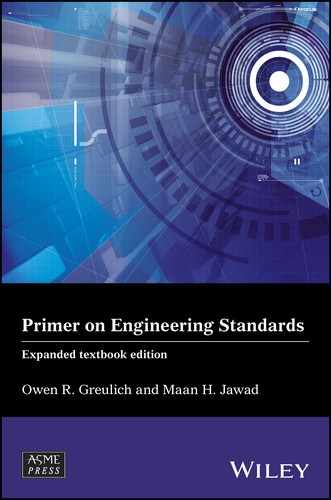Book Description
A Clear, Comprehensive Introduction to Standards in the Engineering Professions
Standards supplement the design process by guiding the designer toward consistency, safety, and reliability. As daily life involves increasingly complex and sophisticated instruments, standards become indispensable engineering tools to ensure user safety and product quality. Primer on Engineering Standards: Expanded Textbook Edition delves into standards creation and compliance to provide students and engineers with a comprehensive reference.
The different types of standards are dissected and discussed in terms of development, value, impact, interpretation, and compliance, and options are provided for situations where conformance is not possible. The process of standards creation is emphasized in terms of essential characteristics and common pitfalls to avoid, with detailed guidance on how, where, and with whom one may get involved in official development.
Organized for both quick reference and textbook study, this new Expanded Textbook Edition provides a quick, clear understanding of critical concepts, ramifications, and implications as it:
- Introduces the concepts, history, and classification of standards, rules, and regulations
- Discusses the federal, state, and local government’s role in standards development and enforcement
- Distinguishes voluntary consensus standards, limited consensus standards, and jurisdictional versus non-jurisdictional government standards
- Covers the need for and process of exemptions to existing standards
- Examines the characteristics of a good standard, and discusses opportunities for involvement in development
- Includes case studies to demonstrate standards applications, and extensive appendices to direct further inquiry
Table of Contents
- Wiley-ASME Press Series List
- Title Page
- Dedication
- Copyright
- Preface
- Acknowledgments
- Chapter 1: Introduction
- Chapter 2: Role of Governments in Standards
- 2.1 Overview
- 2.2 History
- 2.3 Aspects of Governmental Involvement with Standards
- 2.4 General Policies
- 2.5 National versus State, Provincial, or Local Standards Involvement
- 2.6 The US Government and Standards
- 2.7 US Government OMB Circular A119
- 2.8 National Technology Transfer and Advancement Act
- 2.9 National Science and Technology Council
- 2.10 Other US Government Actions
- 2.11 How the Government Uses Standards
- 2.12 US Government as a Participant in VCS Activities
- 2.13 State and Local Standards Use
- 2.14 Other Countries
- 2.15 Summary
- 2.16 Case Studies
- Chapter 3: Voluntary Consensus Standards and Codes
- Chapter 4: Limited Consensus Standards
- Chapter 5: Jurisdictional Standards
- Chapter 6: Standards Development Process
- Chapter 7: Types of Standards
- Chapter 8: Conformity Assessment
- Chapter 9: Standards Interpretation and Relief
- Chapter 10: Characteristics of a Good Standard
- Chapter 11: Getting Involved in Standards Development
- Acronyms
- Appendix A: Deciding Not to Use a Standard
- Appendix B: Some SDOs developing Voluntary Consensus Standards
- Appendix C: Some Industrial Organizations That Publish Limited Consensus Standards
- Appendix D: Some US Government Jurisdictional Agencies
- Bibliography
- Biography
- Index
- End User License Agreement
